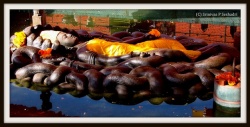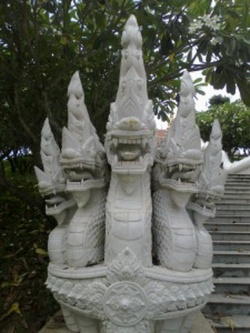Difference between revisions of "Shesha"
| Line 32: | Line 32: | ||
* "The foremost [[manifestation]] of [[Lord]] [[Vishnu]] is Sankarṣana, who is known as [[Ananta]]. He is the origin of all [[incarnations]] within this {{Wiki|material}} [[world]]. Previous to the [[appearance]] of [[Lord]] {{Wiki|Śrī Kṛṣṇa}}, this original Sankarṣana will appear as Baladeva, just to please the [[Supreme]] [[Lord]] [[Śrī Kṛṣṇa]] in His [[transcendental]] pastimes." ({{Wiki|Bhāgavata Purāṇa}} 10.1.24) | * "The foremost [[manifestation]] of [[Lord]] [[Vishnu]] is Sankarṣana, who is known as [[Ananta]]. He is the origin of all [[incarnations]] within this {{Wiki|material}} [[world]]. Previous to the [[appearance]] of [[Lord]] {{Wiki|Śrī Kṛṣṇa}}, this original Sankarṣana will appear as Baladeva, just to please the [[Supreme]] [[Lord]] [[Śrī Kṛṣṇa]] in His [[transcendental]] pastimes." ({{Wiki|Bhāgavata Purāṇa}} 10.1.24) | ||
| − | * "Śrī Anantadeva has thousands of faces and is fully {{Wiki|independent}}. Always ready to serve the [[Supreme]] [[Personality]] of Godhead, He waits upon Him constantly. Sankarṣana is the first expansion of {{Wiki|Vasudeva}}, and because He appears by His own will, He is called svarāṭ, fully {{Wiki|independent}}. He is therefore [[infinite]] and [[transcendental]] to all limits of [[time]] and [[space]]. He Himself appears as the thousand-headed [[Sesha]]." (Śrīla [[Jiva]] Gosvami, in his Kṛṣṇa-Sandarbha) | + | * "Śrī Anantadeva has thousands of faces and is fully {{Wiki|independent}}. Always ready to serve the [[Supreme]] [[Personality]] of Godhead, He waits upon Him constantly. Sankarṣana is the first expansion of {{Wiki|Vasudeva}}, and because He appears by His own will, He is called svarāṭ, fully {{Wiki|independent}}. He is therefore [[infinite]] and [[transcendental]] to all limits of [[time]] and [[space]]. He Himself appears as the thousand-headed [[Sesha]]." (Śrīla [[Jiva]] Gosvami, in his [http://blservices.com/books/previous-acaryas/jiva-goswami/sri-krsna-sandarbha-1919 Kṛṣṇa-Sandarbha] ) |
| − | * "Sankarṣana of the quadruple [[form]] descends with [[Lord]] {{Wiki|Śrī Rāma}} as Lakṣmaṇa. When [[Lord]] Śrī [[Rāma]] disappears, Śeṣa again separates Himself from the [[personality]] of Lakṣmaṇa. Śeṣa then returns to His own [[abode]] in the Pātala regions, and Lakṣmaṇa returns to His [[abode]] in [[Vaikuṇṭha]]." (A. C. Bhaktivedanta Svāmi Śrīla Prabhupāda) | + | * "Sankarṣana of the quadruple [[form]] descends with [[Lord]] {{Wiki|Śrī Rāma}} as Lakṣmaṇa. When [[Lord]] Śrī [[Rāma]] disappears, Śeṣa again separates Himself from the [[personality]] of Lakṣmaṇa. [[Śeṣa]] then returns to His own [[abode]] in the Pātala regions, and Lakṣmaṇa returns to His [[abode]] in [[Vaikuṇṭha]]." ([[Wikipedia:A. C. Bhaktivedanta Swami Prabhupada|A. C. Bhaktivedanta Svāmi Śrīla Prabhupāda]]) |
| − | * In the Bhagavadgītā, when in the middle of the battlefield Kurukṣetra, [[Śrī Kṛṣṇa]] explaining his {{Wiki|omnipresence}}, says: "Of [[Nāgas]], I am [[Ananta]]" indicating the importance of [[Ananta]] | + | * In the [[Wikipedia:Bhagavad Gita|Bhagavadgītā]], when in the middle of the battlefield [[Wikipedia:Kurukshetra|Kurukṣetra]], [[Śrī Kṛṣṇa]] explaining his {{Wiki|omnipresence}}, says: "Of [[Nāgas]], I am [[Ananta]]" indicating the importance of [[Ananta Śeṣa]]. |
==Other names== | ==Other names== | ||
| − | * Śeṣanāga ([[Sesha]] the [[serpent]]) | + | * [[Śeṣanāga]]; ([[Sesha]] the [[serpent]]) |
| − | * Ādiśeṣa (the first [[Sesha]]) | + | * [[Ādiśeṣa]]; (the first [[Sesha]]) |
| − | * Anantaśeṣa ([[Endless]] [[Sesha]]) | + | * [[Anantaśeṣa]]; ([[Endless]] [[Sesha]]) |
| − | * [[Ananta]] (endless/infinite). | + | * [[Ananta]]; (endless/infinite). |
| − | * Alternative spelling: [[Sesa]], [[Sesha]], Śeṣa. | + | * Alternative spelling: [[Sesa]], [[Sesha]], [[Śeṣa]]. |
| − | * Śeṣa Sāyana or [[Nāga]] | + | * [[Śeṣa Sāyana]]; or [[Nāga Sāyana]]; means [[Vishnu who sleeps]] ([[Sāyana]]) on [[Śeṣanāga]] |
| − | * Nāga-ābharaṇa means [[Śiva | + | * [[Nāga-ābharaṇa]]; means [[Śiva who has the [[Nāgas]] worn as Ornaments |
{{W}} | {{W}} | ||
[[Category:Nagas]] | [[Category:Nagas]] | ||
Revision as of 13:10, 5 September 2014
In Hindu (post-Vedic) tradition, Shesha (IAST: Śeṣa, Devanagari: शेष), also known as Sheshanaga (IAST: Śeṣanāga, Devanagari: शेषनाग) or Adishesha (IAST: Ādi Śeṣa, Devanāgarī: आदिशेष) is the king of all Nagas (serpent deities), one of the primal beings of creation, and according to the Bhagavata Purana, an avatar of the Supreme God known as Narayana. He is also known as Balarama and Sankarshana. In the Puranas, Sheshanaga is said to hold all the planets of the Universe on his hoods and to constantly sing the glories of Vishnu from all his mouths. He is sometimes referred to as Ananta Shesha which translates as endless-Shesha or as Adishesha which means the first Shesha. It is said that when Adishesa uncoils, time moves forward and creation takes place. When he coils back, the universe ceases to exist. "Shesha" in sanskrit texts, especially those relating to mathematical calculation, also implies the "remainder" – that which remains when all else ceases to exist.
Sheshanaga is also considered a dasa (servant) as well as also a manifestation, or avatar, of Lord Maha Vishnu himself. Ananta Sheshanaga is said to have descended to Earth in four human forms or avatars: Lakshmana, brother of Lord Sri Rama, Balarama, brother of Lord Sri Krishna, Ramanuja and Manavala Mamunigal. Maharsi Patanjali's the major compiler of yogic traditions is also considered to be an incarnation of the great Shesha.
Form
Shesha is generally depicted with a massive form that floats coiled in space, or on the ocean of milk, to form the bed on which Vishnu lies. Sometimes he is shown as five-headed or seven-headed, but more commonly as a many thousand-headed serpent, sometimes with each head wearing an ornate crown.
His name means "that which remains", from the Sanskrit root śiṣ, because when the world is destroyed at the end of the kalpa, Shesha remains as he is.
In the Bhagavadgita of Chapter 10, verse 29, Sri Krishna while describing 75 of his common manifestations, declares, "anantaś ca asmi nāgānāṁ": Of the nagas, I am Ananta.
As per the Mahabharata, Shesha was born to sage Kaśyapa and his wife Kadru. Kadru gave birth to a thousand snakes, of which Shesha was the eldest. After Shesha, were born Vāsuki, Airāvata and Takṣaka, in order. A lot of Śeṣa’s brothers were cruel in nature and were bent upon inflicting harm on others. They were even unkind to Garuda, who was Kaśyapa’s son through Vinatha, sister of Kadru. (Kadru and Vinatha were daughters of Daksha). Śeṣa, disgusted by the cruel acts of his brothers, left his mother and kin, and took to austere penances. He lived on air, and meditated in various places including Gandhamadhana, Badrikāshrama, Gokarna, Pushkara and Himalayas. His penances were so severe that his flesh, skin and muscles dried up and merged with his frame. Brahmā, convinced of his Śeṣa's will, asked Śeṣa to request a boon. Shesha asked that he be able to keep his mind under control so that he could continue to perform ascetic penances. Brahmā gladly accepted the request. Brahma then asked a favour of Śeṣa, that of to go beneath the unstable earth and stabilize it. Śeṣa agreed and went to the netherworld, and stabilized her with his hood. He is known to support her even today, thus making Pātala his perennial residence. (Mbh, Ādi Parva) Maha Vishnu and Maha Lakshmi
Shesha is also depicted as floating in the ocean of the changing world, forming the bed of Maha Vishnu. He is also known as Adishesha (the foremost of snakes) because of this and Anantashesha or simply Ananta (endless, as he is known to remain in existence even after the end of the Kalpa, when the whole universe is destroyed).
Other details
Balarāma, Lakṣmaṇa, Rāmānuja, Manavala Mamunigal, and Nityānanda Prabhu, are considered avatarā of Śeṣanāga (or vice versa). Maharṣi Patañjali is also considered an emanation or incarnation of Śeṣanāga himself and is iconographically depicted in nāga form with nāga canopy.
In a story from the Purāṇas, Śeṣa's young brother Vasuki loosens Mount Mandara, to enable it to be used in the churning of the ocean by the devas and asuras.
According to the Mahābhārata (Ādi Parva), his father was Kaśyapa and his mother Kadru.
The city of Thiruvananthapuram is named after him as the "City of Lord Ananta."
The Nair clan in southern part of Kerala and the Bunt community of the Tulu Nada region of Karnataka and Kerala are considered to be the descendants of The Great Serpent Ananta.
Quotations
- "The foremost manifestation of Lord Vishnu is Sankarṣana, who is known as Ananta. He is the origin of all incarnations within this material world. Previous to the appearance of Lord Śrī Kṛṣṇa, this original Sankarṣana will appear as Baladeva, just to please the Supreme Lord Śrī Kṛṣṇa in His transcendental pastimes." (Bhāgavata Purāṇa 10.1.24)
- "Śrī Anantadeva has thousands of faces and is fully independent. Always ready to serve the Supreme Personality of Godhead, He waits upon Him constantly. Sankarṣana is the first expansion of Vasudeva, and because He appears by His own will, He is called svarāṭ, fully independent. He is therefore infinite and transcendental to all limits of time and space. He Himself appears as the thousand-headed Sesha." (Śrīla Jiva Gosvami, in his Kṛṣṇa-Sandarbha )
- "Sankarṣana of the quadruple form descends with Lord Śrī Rāma as Lakṣmaṇa. When Lord Śrī Rāma disappears, Śeṣa again separates Himself from the personality of Lakṣmaṇa. Śeṣa then returns to His own abode in the Pātala regions, and Lakṣmaṇa returns to His abode in Vaikuṇṭha." (A. C. Bhaktivedanta Svāmi Śrīla Prabhupāda)
- In the Bhagavadgītā, when in the middle of the battlefield Kurukṣetra, Śrī Kṛṣṇa explaining his omnipresence, says: "Of Nāgas, I am Ananta" indicating the importance of Ananta Śeṣa.
Other names
- Śeṣanāga; (Sesha the serpent)
- Ādiśeṣa; (the first Sesha)
- Anantaśeṣa; (Endless Sesha)
- Ananta; (endless/infinite).
- Alternative spelling: Sesa, Sesha, Śeṣa.
- Śeṣa Sāyana; or Nāga Sāyana; means Vishnu who sleeps (Sāyana) on Śeṣanāga
- Nāga-ābharaṇa; means [[Śiva who has the Nāgas worn as Ornaments


